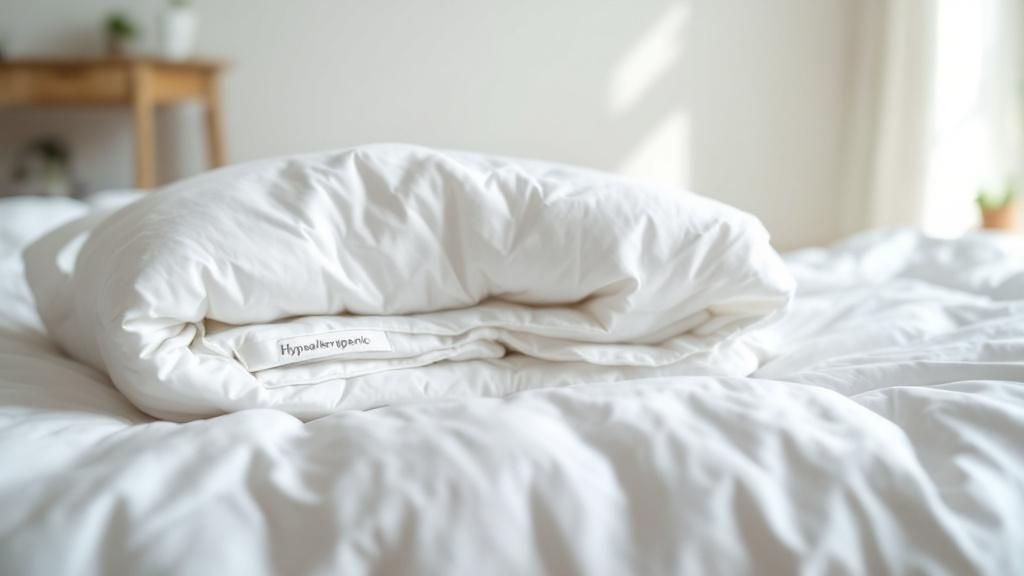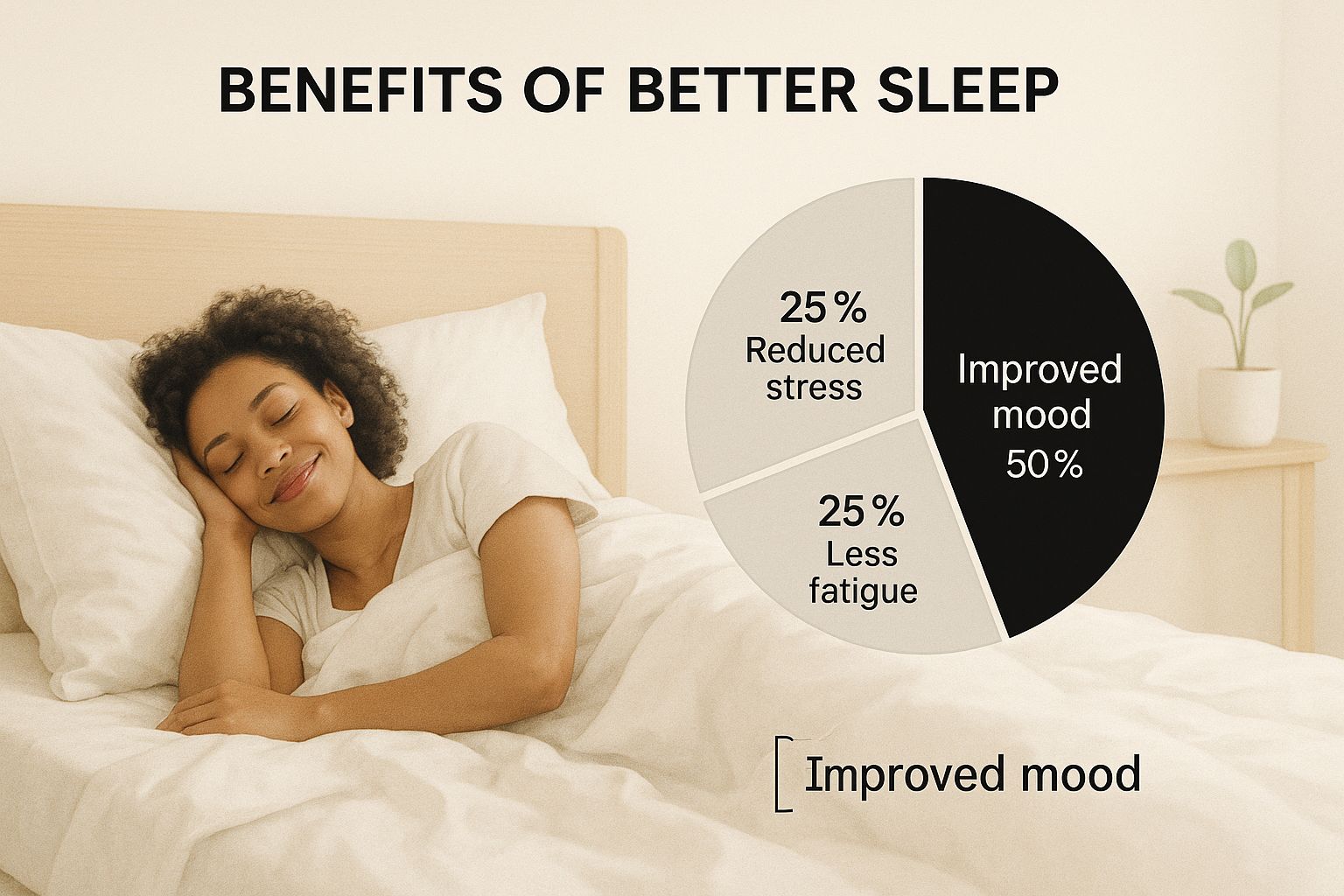If you've ever woken up with a stuffy nose or itchy eyes, you know how frustrating it can be. More often than not, the culprit is lurking right in your own bed. This is where hypoallergenic bedding comes in—it’s specifically engineered to shield you from common irritants like dust mites, pet dander, and mold, helping you get a much better night's sleep.
Why Hypoallergenic Bedding Is Your First Line of Defense

The word "hypoallergenic" simply means a product is less likely to trigger an allergic reaction. When it comes to bedding, this means using materials and weaves that actively resist those pesky household allergens. Even when freshly washed, traditional bedding can quickly become a haven for microscopic pests and even mold.
For many of us, especially anyone with asthma or sensitive skin, the connection between our bedding and nightly symptoms is undeniable. Creating a cleaner sleeping space is one of the most direct and effective things you can do for your health.
How These Materials Actually Work
The concept behind hypoallergenic bedding is pretty straightforward, but it's incredibly effective. It generally works in two key ways: by creating a physical barrier and by using naturally resistant fibers.
- Tightly Woven Fabrics: Think of materials like long-staple cotton or bamboo. The weave on these fabrics is so tight that the pores are too tiny for dust mites and their waste to pass through. It essentially seals them out of your personal space.
- Naturally Resistant Fibers: Other materials, like wool or silk, have their own built-in defenses. They are often moisture-wicking, which draws sweat and humidity away from your body. This prevents the damp environment that mold and mildew need to thrive.
A Growing Focus on Healthier Sleep
This isn't just a niche trend anymore; it's a major shift in how we think about our sleep environments. The global market for hypoallergenic pillows was valued at around USD 3.5 billion in 2023 and is expected to climb to nearly USD 6.8 billion by 2032. This surge is fueled by a growing public awareness of just how much allergens can affect our breathing and overall health. You can read more about the rise of hypoallergenic bedding market trends to see the data for yourself.
I’ve seen this firsthand. A family I know has a child who struggles with nighttime asthma. They decided to switch everything—from the pillow protectors to the duvet—to hypoallergenic options. The change was dramatic. The child’s nighttime coughing and congestion dropped significantly, which meant everyone in the house finally got more restful sleep. It’s a perfect example of how making a conscious choice about your bedding can have a real-world impact.
Finding Your Ideal Hypoallergenic Bedding Material
When you're trying to find relief from allergies, wading through endless fabric options can feel like a chore. The thing is, the right hypoallergenic bedding does more than just feel soft—it actively builds a cleaner, healthier place for you to sleep. Your personal preferences, like whether you sleep hot, have sensitive skin, or are keeping an eye on your budget, will ultimately point you to the perfect choice.
Let's walk through the most popular and effective materials out there. Each one brings something unique to the table in the fight against allergens, and once you understand their strengths, you'll be able to choose with confidence.
Natural Fibers That Defend Your Sleep
Some of the most powerful hypoallergenic materials are gifts from nature. These fabrics have built-in properties that make them naturally unwelcoming to common triggers like dust mites, mold, and mildew.
-
Long-Staple Cotton: Not all cotton is the same. When you see terms like Egyptian or Pima cotton, it refers to varieties with extra-long fibers. These fibers create an incredibly tight weave (think percale or sateen) that acts as a physical shield, making it nearly impossible for dust mites to pass through.
-
Bamboo: If you're a hot sleeper or deal with skin sensitivities, bamboo-derived fabrics are a game-changer. Bamboo is fantastic at wicking moisture away from your body, which helps prevent the damp, humid conditions that mold and mildew thrive in. Plus, it's unbelievably soft.
-
Silk: It might feel like a splurge, but silk is a true hypoallergenic workhorse. It naturally contains proteins that actively repel dust mites and mold. On top of that, its incredibly smooth surface is gentle on irritated or acne-prone skin, minimizing friction and discomfort.
-
Wool: This one might surprise you, but wool is an excellent choice, particularly for comforters, duvets, and mattress pads. Its superpower is moisture management. Wool pulls moisture away from you and the mattress, keeping your entire sleep setup dry and hostile to mold spores.
The best hypoallergenic bedding doesn't just put a band-aid on the problem. It fundamentally changes your sleep environment, making it a place where allergens simply can't flourish. A dry, breathable bed is an allergen's worst nightmare.
Making the switch can dramatically improve your rest, helping you wake up feeling refreshed instead of congested.

This really drives home the main goal: finding bedding that brings you genuine comfort and relief, which is a cornerstone of good health.
Comparing Top Hypoallergenic Bedding Materials
To make this even easier, here’s a quick side-by-side look at how these materials stack up. Everyone's needs are different, so think about what matters most for your sleep.
| Material | How It Fights Allergens | Best For | Feel & Comfort |
|---|---|---|---|
| Long-Staple Cotton | The super-tight weave creates a physical barrier. | All-around protection and value-conscious shoppers. | Classic hotel feel—crisp and cool (percale) or silky-smooth (sateen). |
| Bamboo | Naturally antimicrobial and wicks away moisture. | Hot sleepers, anyone with sensitive skin, eco-friendly homes. | Incredibly soft, drapes beautifully, and feels cool to the touch. |
| Silk | Its proteins naturally repel dust mites and mold. | People with very sensitive or acne-prone skin; luxury comfort. | Unmatched smoothness, feels luxurious, and helps regulate temperature. |
| Wool | Pulls moisture away to create a dry environment. | Colder climates or anyone needing year-round temperature control. | Cozy but breathable. Excellent for mattress pads and duvet inserts. |
Ultimately, the goal is to find the material that checks all of your boxes. If you're ready to dig deeper and compare specific product types, our complete guide on the best hypoallergenic bedding can help you find the perfect match for your bedroom.
Building Your Allergy-Proof Sleep Sanctuary

If you're tired of waking up stuffy and congested, it's time to turn your bedroom into a true sanctuary. This isn't about just swapping out one pillowcase; it's a thoughtful process of building a defense system, starting from the mattress and working your way up. Each layer you add works together to keep irritants at bay.
The single most important place to start is with your mattress and pillows—the biggest reservoirs for allergens in any bedroom. Think of zippered encasements as your foundational armor. These protectors have an incredibly tight weave that traps existing dust mites, dander, and mold spores inside, preventing them from becoming airborne while you sleep.
Once you've locked down the existing allergens, every other piece of bedding you add builds on that clean, protected base. This layering approach means you're surrounded by materials that actively fight back against new allergens trying to move in.
Assembling Your Protective Layers
With the mattress and pillows safely zipped up, we can turn our attention to the layers you actually touch every night. This is where your choice of pillows, a comforter, and, of course, your sheets makes all the difference.
-
Pillows and Comforters: Look for fills made from naturally resistant materials. Bamboo and wool are fantastic choices because they do a great job of managing moisture, which makes them a terrible place for mold to grow.
-
Sheets and Pillowcases: This is the final, crucial layer. Your sheets are in direct contact with your skin all night long. To make the best choice, you can dive into our detailed guide on the best sheets for allergies and find the perfect fabric for your comfort and sensitivity.
A pro tip I always share is to look for the OEKO-TEX Standard 100 certification on the label. This is your guarantee that the bedding is free from a whole list of nasty chemicals and synthetic finishes that often trigger skin or respiratory irritation.
The Power of High-Quality Covers
Investing in good protective covers is probably the most impactful thing you can do. It's a small change with a huge payoff, and people are catching on. The market for hypoallergenic pillow covers alone was valued at USD 1.2 billion in 2024 and is expected to more than double to USD 2.5 billion by 2033. That explosive growth shows a real shift as people look for targeted, effective allergy solutions.
By carefully choosing each piece of your bedding, you transform your bed from a source of nightly irritation into a place of genuine rest. This is about more than just managing symptoms—it's about creating a truly healthy space for deep, restorative sleep.
Keeping Your Bedding Working Hard for You
Choosing high-quality hypoallergenic bedding is a brilliant move for better sleep, but that initial investment is only half the battle. Think of it this way: even the most tightly woven, allergen-resistant fabric will eventually collect dust mites and dander if it isn't cared for properly. Consistent maintenance is what truly protects your investment and ensures you keep getting that sweet, sneeze-free relief.
The single most effective weapon against dust mites in your sheets and pillowcases is heat. Washing them weekly in water that's at least 130°F (54°C) is the gold standard for killing off those microscopic critters and their waste.
Now, if you're using specialty materials like bamboo, you'll want to be careful not to damage the delicate fibers. For the full rundown on keeping them silky-soft and effective, take a look at our guide on how to properly care for your bamboo sheets.
Go Beyond Just the Sheets
While your linens are tumbling in the wash, it’s the perfect time to turn your attention to the rest of your bed. Your mattress and pillows are major allergen magnets, and you can't just toss them in the machine. This is where a vacuum with a good HEPA filter becomes your secret weapon.
The goal is to reduce the allergen load in your entire bedroom, not just your sheets. A clean room amplifies the benefits of your hypoallergenic bedding, creating a true sanctuary for rest.
Giving the surface of your mattress, pillows, and even your comforter a thorough vacuuming every few weeks makes a huge difference. This simple step pulls out settled dust mites, pet dander, and other irritants, preventing them from building up deep within the fibers.
Make Your Bedroom an Allergen-Free Zone
Cleaning your bedding is one thing, but creating an environment where allergens struggle to survive is a game-changer. Dust mites and mold absolutely love humidity, so managing your room’s climate is a powerful, proactive strategy.
Here are a few things I always recommend:
- Knock Down the Humidity: Your target is to keep the humidity level in your bedroom below 50%. A dehumidifier is a fantastic tool for this, especially if you live in a damp or humid region.
- Clear the Air: An air purifier with a HEPA filter is another great addition. It works 24/7 to capture airborne allergens like pollen, dander, and mold spores before they ever get a chance to land on your bed.
- Minimize Clutter: Dust loves a good hiding spot. Keeping surfaces clear and clothes put away leaves fewer places for dust to accumulate in the first place.
New Tech for Keeping Allergens at Bay
When we talk about hypoallergenic bedding, we're not just talking about tightly woven cotton anymore. The technology has evolved dramatically, giving us new ways to create a truly clean and safe place to sleep. It’s less about just blocking allergens and more about actively fighting them.
One of the biggest game-changers has been the introduction of antimicrobial treatments. Think of these as a built-in defense system for your bedding. These special finishes are applied directly to the fabric to stop bacteria and mold from ever getting a foothold. It's a proactive approach, rather than just relying on the material itself to resist allergens.
More Than Just a Tight Weave
We're also seeing huge strides in moisture management. Anyone who has woken up sweaty knows how uncomfortable it can be, but that humidity also creates the perfect breeding ground for dust mites and mildew. Modern smart fabrics actively pull that moisture away from your skin, keeping your sleep environment dry and inhospitable to those microscopic pests.
Some of the best bedding now even includes a completely waterproof, yet breathable, membrane. This isn't the crinkly, plastic-like feel of old-school mattress protectors. This is silent, comfortable protection that stops spills and sweat without making you feel like you're sleeping on a tarp.
What we're seeing is a fundamental shift in philosophy. The industry is moving from passive barriers to active defense. Instead of just putting up a wall against allergens, new materials are designed to neutralize the threat entirely.
This push for smarter solutions is what's fueling so much growth in the market. Companies are now laser-focused on creating covers that are not only breathable and waterproof but also have those crucial moisture-wicking and antimicrobial features. They're tackling specific problems, from pet dander to dust mites, head-on. If you're curious about the business side of things, you can read up on these product developments and see where the industry is headed.
Diving Into Hypoallergenic Bedding: Your Questions Answered
If you're thinking about making the switch to hypoallergenic bedding, you probably have a few questions. That's completely normal. Let's walk through some of the most common things people ask, so you can feel confident you're making the right choice for your sleep.
Is Hypoallergenic Bedding More Expensive?
This is probably the number one question I hear. It’s true that you might see a higher price tag on quality hypoallergenic bedding compared to your standard synthetic sets. But it’s helpful to think of it as an investment in your health and comfort, not just a purchase.
Materials like 100% organic bamboo are incredibly durable and hold up wash after wash. Over time, you’ll likely spend less on replacements, which can save you money in the long run.
What's the Real Difference Between "Hypoallergenic" and "Anti-Allergy"?
These terms get thrown around a lot, and it's easy to get them mixed up. They sound similar, but there’s a subtle but important distinction.
- Hypoallergenic: This simply means the material itself is very unlikely to trigger an allergic reaction. Think of naturally gentle fabrics like pure bamboo, silk, or tightly woven cotton.
- Anti-allergy: This label usually means the bedding has been specifically treated or designed to actively fight against allergens. This could be an antimicrobial treatment or a weave so tight that dust mites can't get through.
Frankly, the best bedding does both. It uses a naturally hypoallergenic material that’s also constructed to act as a barrier against those pesky irritants. That two-pronged approach gives you the best shot at a sneeze-free night.
Do I Have to Replace Everything at Once?
The idea of a full bedding makeover can feel overwhelming, especially on your wallet. While swapping everything out at once is the ideal scenario for immediate relief, it's definitely not a requirement.
If you need to make a gradual change, start with what's closest to your skin. Begin by swapping out your pillowcases and sheets. Once you can, add a mattress protector and pillow protectors. Building your allergy-proof sanctuary piece by piece is a perfectly smart way to do it.
Ready to feel the difference for yourself? You can explore the 100% organic, OEKO-TEX certified bamboo bedding collection from Bamtek Home and start building your own allergy-free sleep sanctuary. Find the perfect set at bamtekhome.com.










